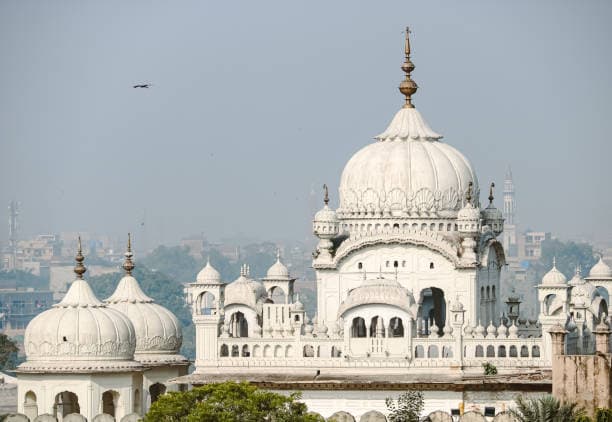Golden Temple in India – A Foreigner’s Complete Travel Guide to Harmandir Sahib
The Golden Temple attracts every visitor, surrounded by golden light and radiant itself in holy waters.
It is this place that differentiates itself because here is where they are not only a temple but the spiritual centre of Sikhism, while the beacon of humanity, love and unity.
Also known as Harmandir Sahib, this place welcomes everyone, no matter your faith or nationality.
Based in Amritsar, Punjab state, it acts as a source of spiritual light for millions around the world.
When you arrive, the atmosphere welcomes you more than with the simply stunning architecture – you feel a great peace, devotion and quietness.
This golden temple in India isn’t just sacred to Sikhs—it’s a sanctuary for all spiritual seekers.
The gold shimmering shrine surrounded by a water tank has a surreal look at first sight.
When crossing the smooth marble as visitors, they often experience a good sense of peace as they come across it.
Inclusivity is a central element of the temple, found in all its offerings, from food, prayer to volunteer work.
So if you’re searching for soulful travel, the Golden Temple Amritsar is a must-see stop.
A Glimpse into the Golden Temple’s History

The story of this sacred site begins in the 16th century, during the time of Guru Arjan Dev.
He founded the temple’s foundation and dug the sacred pool that now bears the name Amrit Sarovar.
The holy pool gave the name to the city, which means “Pool of Nectar”.
The temple had open sides, which were in the form of a peaceful openness to all communities.
Such openness was a marvellous concept, in the light of religious issues prevailing in India at the time.
It was Guru Arjan Dev that had included the Sikh community’s mainstream scripture, the Guru Granth Sahib, in the interior of the temple.
This temple quickly became the pillar where Sikhs of the world could practice their faith and grow spiritually.
Numerous times, the temple was a target for invaders, with Afghan troops among them attacking the temple.
Still, following every invasion, the Sikhs would come up to resurrect it more majestic than previously.
Maharaja Ranjit Singh dressed the sanctum with gold during the 1800s, allowing us to have the beautiful view that we still have, witnessing it.
The Harmandir Sahib is today a tribute to resilience, devotion, and unwavering faith.
What Makes the Golden Temple Unique?

Although the exterior of the temple is simply stunning, it is a symbol of the main spiritual lessons and amiable virtues of humanity.
Sikhs leave the temple open at all times and invite people from all walks of life without discerning their background or beliefs.
Temple’s inclusive design has a significant importance of Sikh equality and the brotherhood of all mankind.
The Langar, or the communal kitchen serving food, is a signature of the temple.
Every day, over 100,000 people are fed free meals that are prepared and served by devoted volunteers.
People from diverse backgrounds and economic classes meet to have plain vegetarian meals.
It’s way more than food —it represents humility, compassion, and selfless gestures.
The neighbouring notable feature is the continuous chanting of the Guru Granth Sahib through the temple.
The temple’s rooms create an ambient chanting which emerges in every corner, adding to a sense of peace and contemplation.
With all the crowd, the area is still a peaceful and serene place.
Beyond being a house of prayer, the Golden Temple is all about passion for spirituality and genuineness of behaviour.
Things to Do at the Golden Temple

Begin your tour by walking around the Parikrama, the free-flowing marbled ring around the holy water tank.
As you go down the path, take note of the still waters of the Amrit Sarovar, which reflect the temple’s glory.
Sit down and sink into the peaceful vibes and soothing chant beside the water's edge.
Join the everyday Palki Sahib Raya, in which the Guru Granth Sahib is brought out for worship with great esteem.
There are two sessions per day in the morning and at night, when heartfelt prayers and emotional solemnity call to order.
Join in Langar Seva and work in the kitchen to cook or serve food.
Seeing people of different backgrounds working together in wonderful harmony is an inspiring moment indeed.
Don’t fail to pay a stopover at the Central Sikh Museum, which is found right at the entrance of the temple grounds.
View the exhibits and paintings which outline Sikh heritage, hard times, and spiritual philosophies.
There are many things to do in the Golden Temple, each adding meaning to your journey.
Best Time to Visit the Golden Temple

To experience comfortable weather, the best time to visit is between October and March, that is, in November when temperatures are moderate in Amritsar.
In summer (April–June), temperatures are high, so walking barefoot through the complex becomes all the more nauseating.
Plan your trip to coincide with Gurpurab or Baisakhi to be part of the big tidal waves of festivities and religiosity.
Illumination and music galore create festive parades around the temple, while a sea of anticipated pilgrims decorates the place.
A peaceful visit can be planned if the visitation is outside for the Amrit Vela before the break of dawn.
The mystical feeling in the temple is created by Amrit Vela, which is in the morning, with gentle chants carried along by fresh air.
Stay at the temple and behold as the lights cast the water with the stars twinkling from below.
If it bothers you to be in a crowd, then you might as well travel on weekdays, when the complex is calmer. During weekdays, the temple is often more peaceful and less crowded than on weekends.
Since the temple remains open, night visits become a peaceful environment for reflection and association with yourself.
Check for updates for local events and special occasions while you are planning your trip.
No matter the season, every time is the best time to visit the Golden Temple in Amritsar in its way.
What to Wear & Etiquette Tips

Make sure that men and women cover their heads before entering the temple.
If you happen to arrive without one, then free scarves are made available to any visitor at the entrance waits for any visitor who needs one.
Be aware of your clothing – have to be in decent and conservative dressing, no shorts, sleeveless tops or body hugging outfits.
Remove your footwear and socks and wash your hands and feet at the designated water stations.
There is no facility upon entry which permits tourists to bring alcohol, tobacco or drugs to the Golden Temple area.
Be mindful of the tone when in the temple; high volumes in the temple may not meet the soothing environment.
You can capture photos outside the temple, but don’t take photos inside the holy sanctum.
Please, walk around the Parikrama in a clockwise manner, following the traditional ritual of respect.
Don’t point your feet at the holy space or the scripture.
Make room to watch your fellow visitors to ensure respectful discipline all around.
These Golden Temple rules help ensure a peaceful and respectful experience for everyone.
Nearby Attractions to Add to Your Amritsar Tour

A short walk will have you in Jallianwala Bagh, a historic garden remembered for its tearful past.
It’s where hundreds of peaceful Indians were killed in 1919 by British troops—a deeply emotional site.
Visit the Partition Museum and explore the story of 1947 through the meaningful personal accounts of letters and pictures.
Experience every day the infamous Wagah Border Ceremony – approximately 30 kilometres north of Amritsar, along the India-Pakistan border.
This is an event marked by noisy, violent military demonstrations, catchy patriotic music, and a feeling of national pride.
Visit Gobindgarh Fort, an 18th-century fortress is nicely kept with museums, exhibits, and performances of Punjabi traditions.
Eat at local food stalls around and purchase traditional clothes or handicrafts as one peruses the fort.
Walk around the old streets and historical houses of Old Amritsar with a walking tour.
Visit the Durgiana Temple for a quiet space comparable to the Golden Temple.
Each of these places to visit in Amritsar near the Golden Temple adds depth to your travel story.
You will comprehensively appreciate Amritsar’s culture, food and immanence if you stay there for at least two full days.
Conclusion
The Golden Temple or the Sikh in Amritsar, aside from being a popular attraction is a place where peace and kindness is common place and people with deep faiths can be found.
Its gilded exterior and modest vegetarian fare and spiritual hymns bring you close in an unforgettable way.
You can come as a visitor and you’ll leave lighter and calmer, deeply connected to something other than yourself.
Whether you’re on a journey of the spirit or merely Trip to India, the temple is still an admirable experience.
Spend a few minutes sitting by the water, stop and just enjoy the surrounding environment.
The acts of quiet reflection are the things travellers take home once they’ve gone.
So wear warmer clothes, lift your spirit and get to Amritsar to get an enlightening spiritual experience today.
Let the divine energy of Harmandir Sahib refresh your soul and inspire your journey.
Some spots can’t be paired with a place and become never to be never-to-be-forgotten part of your life on the other side of the years, after you leave.
Add the Golden Temple travel guide to your bucket list—you won’t regret a single moment spent here.
Book Your Tour
Reserve your ideal trip early for a hassle-free trip; secure comfort and convenience!
